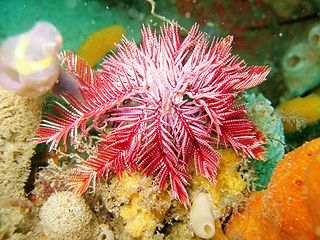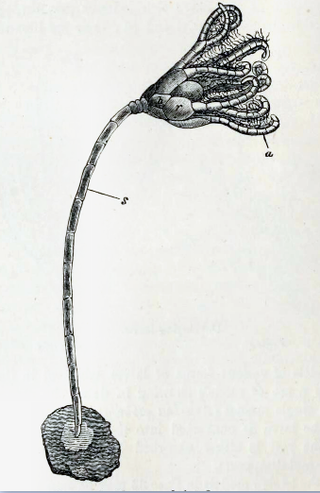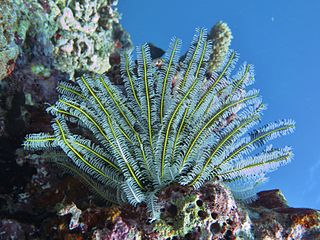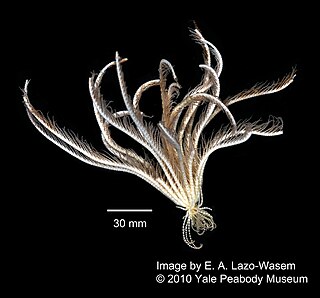
Crinoids are marine invertebrates that make up the class Crinoidea. Crinoids that remain attached to the sea floor by a stalk in their adult form are commonly called sea lilies, while the unstalked forms, called feather stars or comatulids, are members of the largest crinoid order, Comatulida. Crinoids are echinoderms in the phylum Echinodermata, which also includes the starfish, brittle stars, sea urchins and sea cucumbers. They live in both shallow water and in depths of over 9,000 metres (30,000 ft).

Articulata are a subclass or superorder within the class Crinoidea, including all living crinoid species. They are commonly known as sea lilies or feather stars. The Articulata are differentiated from the extinct subclasses by their lack of an anal plate in the adult stage and the presence of an entoneural system. Articulata first appeared in the fossil record during the Triassic period although other, now extinct crinoid groups, originated in the Ordovician.

Bispira brunnea, the social feather duster or cluster duster, is a species of marine bristleworm. They tend to live in groups of individuals, and are common off the Caribbean islands in southeast North America. The feather duster has one crown of various colors, however, the color of the crown seems to be consistent within individual colonies.

Comasteridae is a family of crinoids.

Spondylus americanus, the Atlantic thorny oyster, is a species of bivalve mollusc. It can be found along the Atlantic coast of North America, ranging from North Carolina to Brazil.

Antedon bifida is a species of crinoid in the family Antedonidae commonly known as the rosy feather star. It is found in north west Europe.

Comatulida is an order of crinoids. Members of this order are known as feather stars and mostly do not have a stalk as adults. The oral surface with the mouth is facing upwards and is surrounded by five, often divided rays with feathery pinnules. Comatulids live on the seabed and on reefs in tropical and temperate waters.
Iotrochota birotulata, commonly known as the green finger sponge, is a species of sea sponge in the family Iotrochotidae. It is found in shallow waters in the Caribbean Sea.

Davidaster rubiginosus, the orange sea lily, is a species of crinoid in the family Comatulidae. At one time it was classified as Nemaster rubiginosa but the World Register of Marine Species has determined that the valid name is Davidaster rubiginosus. It is found on reefs in the tropical western Atlantic and the Caribbean Sea.

Bartholomea annulata is a species of sea anemone in the family Aiptasiidae, commonly known as the ringed anemone or corkscrew anemone. It is one of the most common anemones found on reefs in the Caribbean Sea.

Ophiothrix suensoni, Suenson's brittle star or the sponge brittle star, is a species of marine invertebrate in the order Ophiurida. It is found in the Caribbean Sea and Gulf of Mexico. It is included in the subgenus Acanthophiothrix making its full scientific name Ophiothrix (Acanthophiothrix) suensoni.

Euapta lappa, the beaded sea cucumber, is a species of sea cucumbers in the family Synaptidae in the phylum Echinodermata. It is found on coral reefs in the Caribbean region.

Comaster schlegelii, the variable bushy feather star, is a crinoid in the family Comatulidae. It was previously classified as Comanthina schlegeli but further research showed that it was better placed in the genus Comaster. It is found on shallow water reefs in the western Pacific Ocean.

Metacrinus rotundus, the Japanese sea lily, is a species of stalked crinoid in the family Isselicrinidae. It is a species found off the west coast of Japan, near the edge of the continental shelf at a depth of around 100 to 150 metres deep. This is the shallowest-living species among the extant stalked crinoids.

Antedon mediterranea is a species of stalkless crinoid in the family Antedonidae, commonly known as the Mediterranean feather star. It is found on the seabed at moderate depths in the Mediterranean Sea. It is a filter feeder and captures plankton with its long feathery arms.

Ptilometra australis, the passion flower feather star, is a species of crinoid. It is native to the coasts of southeastern Australia where it is found on reefs, in estuaries and bays at depths down to about 110 metres (360 ft).

Plumapathes pennacea is a species of black coral in the order Antipatharia. It is found in the tropical Indian, Pacific and Atlantic Oceans in deep reef habitats where it forms part of a biologically diverse community.

Florometra serratissima is a species of crinoid or feather star in the family Antedonidae. It is found off the Pacific coast of North America, usually in deep water.

Promachocrinus kerguelensis is a species of free-swimming, stemless crinoids. It was the only member of its genus until several species were discovered in 2023. P. keruguelensis a coldwater crinoid which is found in the seas around Antarctica and surrounding island groups, including under the sea ice.

Aporometra wilsoni is a marine invertebrate, a species of crinoid or feather star in the family Aporometridae. It is found in shallow water around the coasts of southern Australia.


















